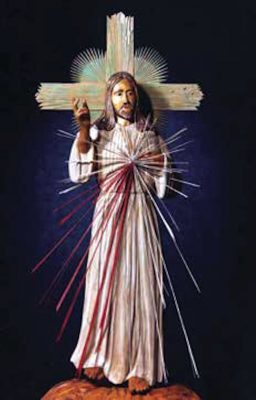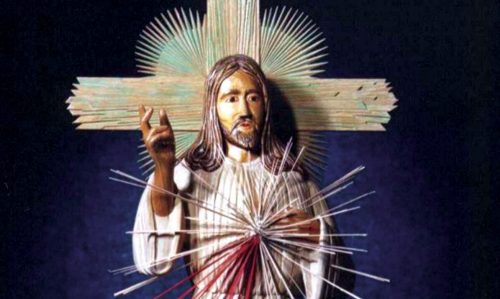Divine Mercy Sunday will be celebrated April 24 at St. Faustina’s Chapel of Divine Mercy, a shrine within St. Paul Church in Sauk Centre. Near the side altar are encased relics of Sts. Faustina and Maximilian Kolbe.
It will be the 40th anniversary of celebrating Divine Mercy Sunday at St. Paul’s. Observing the feast in Sauk Centre is a tradition that began long before St. John Paul II canonized St. Faustina in 2002 and declared the Sunday after Easter as Divine Mercy Sunday.
The afternoon begins with adoration at 1 p.m., followed by the sacrament of reconciliation, praying the Chaplet of Divine Mercy and Benediction. Mass is at 4 p.m. (See box.)
Father Greg Paffel, pastor of the Parishes on the Prairie Area Catholic Community, which includes St. Paul’s, described the beginnings of Divine Mercy Sunday in the St. Cloud Diocese.

“In 1980, Roman Kulzer, Paul Theisen, Vern Botz and Deacon Lawrence Kaas were inspired by an article about Divine Mercy in a magazine. On the spot they devoted their lives to spreading the message of Jesus’ merciful love. Little did they know how God’s ocean of mercy would quench the thirst of so many souls in our diocese, across the nation, and even in spots of our sister Diocese of Homa Bay, Kenya,” he said.
“There is no message more pertinent for the world today than the message of Divine Mercy. It can be summed up in five words: ‘Jesus, I trust in you!’ Humanity needs to stop thinking that enduring peace will come through politics, a better economy, a stronger military or anything else. It is Jesus who promises true peace. And that kind of peace only comes when we rely on the Divine Mercy of Jesus,” Father Paffel said.
In 1981, Deacon Kaas carved an image of St. Faustina’s vision of Jesus for the shrine.
“[The carving] gives testimony of great love and faith in the mercy of our Lord,” Father Paffel said. “Paul [Theisen] would sit in the sacristy with me after Mass and tell me story after story of healings and miracles he witnessed through the carving of Divine Mercy. They used to pack it up and bring it to many parishes, homes and even convents to share the wisdom found in the diary of St. Faustina.”
Dedicating St. Paul Church
Of the four men who took St. Faustina’s message to heart, only Roman Kulzer remains.
“After I visited Sacred Heart Church in Freeport, Al Wiechmann gave me a powerful article on Divine Mercy. I asked the others to meet and talk about it — we all wanted to consecrate Sauk Centre to Divine Mercy,” Roman said, recalling some of the events that encouraged them.
[perfectpullquote align=”left” bordertop=”false” cite=”” link=”” color=”” class=”” size=”14″] CELEBRATE DIVINE MERCY SUNDAY IN SAUK CENTREWhere: St. Paul Church, 304 Sinclair Lewis Ave., Sauk Centre
When: Sunday, April 24
- 1 p.m. — Exposition of the Blessed Sacrament
- 2-2:45 p.m. — Sacrament of reconciliation
- 3 p.m. — Chaplet and consecration to Divine Mercy
- 3:45 p.m. — Benediction
- 4 p.m. — Mass
A meal will be served afterwards.
Divine Mercy Sunday will also be celebrated at other parishes within the Diocese of St. Cloud. View a list of celebrations here. [/perfectpullquote]
“Father Elmer Torborg, our pastor at that time, agreed. Bishop George Speltz was eager to promote the message of Divine Mercy and place the shrine at St. Paul’s. Though that took a while to accomplish, it confirmed that what we were trying to do was God’s plan, not ours,” Roman said.
“At our dedication Sunday, Father Richard J. Drabik, a provincial from Stockbridge, Massachusetts [where today the National Shrine of the Divine Mercy is located], asked to attend. And Robert and Maureen Digan, who had gone to Poland, where she and their son were healed at the tomb of St. Faustina, gave a testimonial to that healing, which was later used in St. Faustina’s canonization documents.
“When our friend Fran Crosby was dying of cancer, just three days before he died, we brought the image of Divine Mercy,” Roman said. “He saw in it a living Jesus that gave him the peace of Jesus’ presence. God’s mercy is unlimited and we as individuals have power to bring others to his presence.”
Father Todd Schneider, a former pastor of St. Paul’s, learned through research that St. Cloud Bishop James Trobec had laid the cornerstone of the church on Mercy Sunday, April 10, 1904, at 3 p.m., the Hour of Mercy which is the hour of Jesus’ death. “So St. Paul’s was a ‘mercy’ church even before Divine Mercy Sunday had been declared,” Roman added.






















